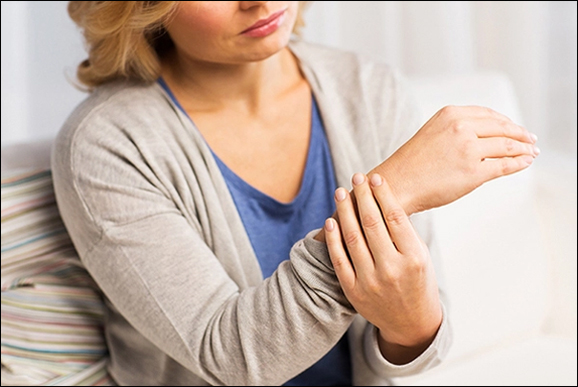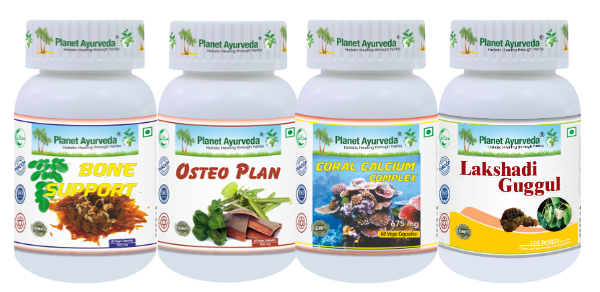Ayurveda and Bone Health : Is Natural Recovery from Low Bone Density Possible?
Abstract
Bones are living tissues that constantly regenerate and renew throughout an individual’s life. Bone density refers to the amount of minerals, mainly calcium and phosphorus, present in a certain volume of bone. A higher bone density means stronger bones, while lower bone density indicates weakened bone structure. Bone density is often used as a diagnostic tool to assess the strength and health of bones. Low bone density is a condition characterized by reduced bone mass, which increases the risk of fractures and bone-related disorders. This condition can progress into osteoporosis, where bones become brittle and highly susceptible to fractures. The loss of bone density is a common concern, especially among aging populations, and can be influenced by a range of factors including genetic, lifestyle, and hormonal imbalances.

Introduction
Low bone density is a precursor to osteoporosis, a condition where the bones become porous, fragile, and more susceptible to fractures. It occurs when the bones lose more minerals, particularly calcium, than they can replace. According to Centers for disease control and prevention (CDC), the prevalence for low bone density in adults aged above 50 years is about 43.1%. Here a higher prevalence is seen in females at 51.5% when compared to the males at 33.5%. Osteoporosis and osteopenia are often called “silent diseases” because they don’t typically cause symptoms until a fracture occurs. With advancements in medical research, early detection, and appropriate management strategies, individuals with low bone density can lead healthy lives while mitigating the risk of serious complications.
Causes
Several factors influence bone density and it is most commonly seen as a result of combination of diet, lifestyle, social and genetic factors. These are:
1. Age and Gender
The bone density naturally starts decreasing after the age of 30 years. Women are at an increased risk for low bone density, especially after menopause as estrogen levels decrease. Also women have a lower peak bone density physically when compared to men.
2. Nutritional Deficiencies
Insufficient intake or poor absorption of nutrients like calcium, phosphorus, vitamin D etc. impacts bone health.
3. Genetics
Influence bone size, constitution, and the rate of bone loss, therefore, if your family has a history of decreased bone density your likelihood of having it increases.
4. Hormonal Imbalances
Along with estrogen deficiency, other hormones like low testosterone, increased TSH, or overproduction of cortisol can affect bone density.
5. Long Term Use of Medication
Chronic diseases like diabetes, rheumatoid arthritis, crohn’s disease, ulcerative colitis, etc. can lead to disruption in calcium and vitamin D levels in the body causing depletion in bone density.
In cases of use of chemotherapy or radiotherapy for cancer treatment affects Calcium uptake in the gut.
6. Lifestyle Factors
High caffeine intake, smoking, excessive alcohol consumption directly affect bone metabolism by impairing blood flow to the bones and reducing calcium absorption.
7. Physical Inactivity
A key factor for maintaining bone health is through regular physical activity, like walking, jogging, running, weight training or resistance training. Therefore physical inactivity greatly impacts bone health.
Signs & Symptoms
There are no symptoms seen in initial stages and the person doesn’t even realize about his diminished bone density until unless a fracture occurs. So, the high risk individuals should always be at a lookout. The symptoms can be:
- Fractures from minimal impact or fall are seen.
- Loss of height as vertebrae collapse.
- Due to weakened spine, an abnormal spinal curvature can develop called “kyphosis”.
- Chronic or sudden back pain is commonly seen.
- Joint pain can be present due to other associated conditions like osteoarthritis.
Diagnosis
- BMD: The gold standard for diagnosing low bone density is a DEXA scan (Dual Energy X-ray Absorptiometry). This scan will tell us about the bone density.
| T Score | Bone Health |
|---|---|
| -1 or higher | Indicates healthy bone |
| -1 to -2.5 | Osteopenia |
| -2.5 or lower | Osteoporosis |
- Quantitative Ultrasound (QUS): It is a non-invasive scan which is particularly done for the wrist or heel to assess bone density.
- Blood Tests: Levels of Calcium, Vitamin D, PTH hormone, TSH levels and hormone profile are checked.
- X-Ray: For fractures
Treatment
1. Medications
- Bisphosphonates: drugs like alendronate help in slowing down bone loss.
- Selective Estrogen Receptor Modulators (SERMs): drugs like raloxifene help in preserving bone density.
- Denosumab: a monoclonal antibody that can be used to reduce bone reabsorption.
- PTH Hormone: It is given to stimulate new bone formation.
- HRT: hormone replacement is done in women who are experiencing bone density loss due to menopause.
- NSAIDs and pain killers if required.
2. Calcium and Vitamin D Supplementation
These are advised as they are essential for maintaining bone health.
3. Physical Exercise
Physical activities like jogging, walking, dancing, help stimulate bone formation.
4. Lifestyle Changes
Introduce nutrient rich diet like fortified cereals, leafy greens, omega 3 fatty acid rich foods. Also cessation of smoking and alcohol is necessary.
5. Fall Prevention Strategies
Use of assistive devices, balance training, use of aids to walk, and home safety modifications are advised.
Ayurvedic Overview
In Ayurveda, there isn’t a direct equivalent for osteopenia, but it can be conceptually understood as the depletion of both “Asthi Dhatu” and “Majja Dhatu.” The bone marrow plays a crucial role in repairing and generating bone cells, acting as a reservoir for osteoblasts. Vata dosha is considered to reside within the Asthi (bones) Dhatu, and the depletion (kshaya) of bones occurs primarily due to the imbalance or aggravation of vata dosha. When vata dosha is aggravated by various etiological factors (Vata prakopak nidana-sevana), the body’s metabolic fire (Jathar-agni) gets impaired. This leads to the formation of “ama” (toxins), which causes blockages or obstruction (Stroto-avrodh) in the Asthi and Majja vaha srotas. Therefore, the proper nourishment of both Asthi and Majja dhatu is disrupted. The depletion of Asthi dhatu shows symptoms like hair loss, fatigue, joint pain, and a feeling of looseness in the bones health and joints. The depletion of Majja dhatu leads to bone tissue atrophy, generalized weakness, a sensation of lightness in the bones.
The primary approach for treatment is to restore balance in vata dosha. To achieve this, Basti (medicated enema) using kshira (milk), ghrita (cow’s ghee), and tikta (bitter) herbs is recommended. These three ingredients help promote the “Asthi-vridhi” (growth and nourishment of bones). Also various herbs such as Vacha (Acorus calamus), Ashwagandha (Withania somnifera), Shatavari (Asparagus racemosus), Guduchi (Tinospora cordifolia), and Dadima (Punica granatum) are used internally to help balance the doshas and support bone and bone marrow health.
Herbal Remedies for Low Bone Density by Planet Ayurveda
Planet Ayurveda provides a combination of ayurvedic herbs for the management of Low Bone Density. The medicines beneficial in Low Bone Density are Coral Calcium Capsules, Lakshadi Guggul, Osteoplan Capsules and Bone Support Capsules. All the Planet Ayurveda medicines are 100 % natural, vegetarian, additive free, chemical & preservative free and without any side effects. With ayurvedic intervention, the Low Bone Density can be managed efficiently and thus increasing the quality of life.


Product Description
1. Coral Calcium Capsules
Coral calcium complex is a herbomineral preparation available in the form of capsules and are made from the standardized extract of various compounds like Praval pishti (Coral), Akik pishti (Agate), Kamdudha Ras, Jahar Mohra Pishti, Mukta Pishti (Pearl), and Giloy Ghan Satva (aqueous extract of Tinospora cordifolia). All these ingredients are processed only after proper “Shodhana” procedures i.e., purification. This is an effective source of calcium and the other necessary minerals. Along with it has digestive and carminative properties too which help in the better absorption of these compounds. This is also effective in enhancing muscle strength as it is “Balya” in action and also serves as a “Rasayana” which helps in rejuvenation and improves bone growth.
Dosage: 1 Capsule twice a day
2. Lakshadi Guggul
This is a classical ayurvedic formulation available in the form of capsules. It is prepared from the standardized extract of the herbs such as Laksha (Laccifer lacca), Arjuna (Terminalia arjuna), Ashwagandha (Withania somnifera), Asthisambharaka (Cissus quadrangularis), Nagabala (Grewia populifolia) and Guggul (Commiphora mukul). Arjuna improves the blood circulation, thus simultaneously improves the calcium absorption. Asthisambharaka strengthens the bone and joints and helps in increasing bone density. Guggul and Ashwagandha help in balancing the aggravated Vata dosha providing relief in pain.
Dosage: 2 tablets twice a day
3. Osteoplan Capsules
These capsules are prepared from the standardized extract of Ashwagandha (Withania somnifera), Shatavari (Asparagus racemosus), Arjuna (Terminalia arjuna) and Hadjod (Cissus quadrangularis). These herbs support bone strength due to their Balya (strengthening) properties. Shatavari is packed with natural phyto-hormones, therefore, aids in balancing estrogen levels and proper bone remodeling. Arjuna bark is a rich source of calcium and other essential minerals that contribute in improving bone density and are beneficial for weak and brittle bones.
Dosage: 1 Capsule twice a day
4. Bone Support Capsules
These capsules contain a potent extract of herbs such as Shudha Laksha (Laccifer lacca), Sehjan (Moringa oleifera), Hadjod (Cissus quadrangularis), Arjuna (Terminalia arjuna), Mukta (Pearl Calcium compound), and Praval Pishti (Corallium rubrum). This unique blend enhances calcium absorption and helps in increasing bone density. It also supports the strengthening of cartilage and improves joint flexibility. The Hadjod ingredient is extremely efficient in boosting bone density, while Arjuna contributes to better blood circulation. In addition, Praval Pishti and Mukta naturally help raise calcium levels within the body.
Dosage: 1 Capsule twice a day
Conclusion
Low bone density is a serious but preventable condition that increases the risk of fractures and other bone-related complications. In initial stages it is called Osteopenia and in later severe stages it is called Osteoporosis. A combination of medications, regular physical activity, and proper nutrition is key in treating and managing low bone density. Ayurvedic treatment for Low Bone Density offers a better and a natural approach to improvise bone mineral density. With early detection, proper management, and lifestyle modifications, individuals can reduce the risks associated with low bone density and improve their overall quality of life.





